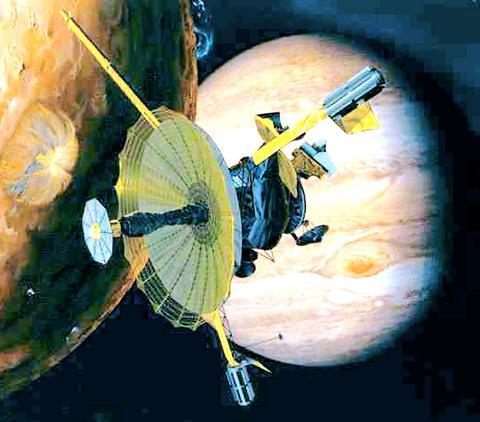Something strange is tugging at America's oldest spacecraft. As the Pioneer 10 and Pioneer 11 probes head towards distant stars, scientists have discovered that the craft -- launched more than 30 years ago -- appear to be in the grip of a mysterious force that is holding them back as they sweep out of the solar system.
Some researchers say unseen "dark matter" may permeate the universe and that this is affecting the Pioneers' passage. Others say flaws in our understanding of the laws of gravity best explain the crafts' wayward behavior.

GRAPHIC: NY TIMES
As a result, scientists are to press a European Space Agency (Esa) meeting, called Cosmic Visions, in Paris this week for backing for a mission that would follow the Pioneers and pinpoint the cause of their erratic movements.
The strange behaviour of the Pioneers -- which swept by Jupiter and Saturn in the 1980's -- was discovered by John Anderson and Slava Turyshev of the Jet Propulsion Laboratory in Pasadena and Michael Martin Neito of the Los Alamos National Laboratory.
They had been tracking the probes using the giant dishes of NASA's Deep Space Network. By the time the two spaceships had swept beyond Pluto, they noted there were persistent anomalies in their trajectories.
Every time they looked the Pioneers were in the wrong place. The effect was not large, but it was significant to draw the attention of the scientists. The two agreed that something more than the Sun's gravity appeared to have a grip on the craft.
The reasons for the anomaly have caused a rift among physicists, however. Some believe the effect may simply be flaws with the probes. Gas from fuel tanks may be leaking from them, slowing their passages, say some astronomers. "Unless there is really good evidence to the contrary, we should stick to simple ideas like these and not go around blaming strange new types of particle or flaws in general relativity," said Professor Martin Barstow, of Leicester University.
But this view has been rejected by Anderson. "It's hard to imagine such a leak happening on both probes at the same time in such a way as to produce an identical acceleration," he said.
And most scientists back him. "The effect is real," said Bernard Haisch of the California Institute for Physics and Astrophysics.
One proposal put forward is that Newton's idea that the force of gravity weakens as distance increases may be incorrect over very large spaces, and may drop off over very long distances.
"It is time to settle the Pioneer issue with a new deep-space mission that will test for, and decide on, the anomaly," Anderson, Turyshev and Nieto state in Physics World.
By fitting a Pioneer follow-up probe with new measuring equipment, navigational device and communications gear, it should be possible to discover if the probes are in the grip of a new force of nature.

This month the government ordered a one-year block of Xiaohongshu (小紅書) or Rednote, a Chinese social media platform with more than 3 million users in Taiwan. The government pointed to widespread fraud activity on the platform, along with cybersecurity failures. Officials said that they had reached out to the company and asked it to change. However, they received no response. The pro-China parties, the Chinese Nationalist Party (KMT) and Taiwan People’s Party (TPP), immediately swung into action, denouncing the ban as an attack on free speech. This “free speech” claim was then echoed by the People’s Republic of China (PRC),

Exceptions to the rule are sometimes revealing. For a brief few years, there was an emerging ideological split between the Democratic Progressive Party (DPP) and Chinese Nationalist Party (KMT) that appeared to be pushing the DPP in a direction that would be considered more liberal, and the KMT more conservative. In the previous column, “The KMT-DPP’s bureaucrat-led developmental state” (Dec. 11, page 12), we examined how Taiwan’s democratic system developed, and how both the two main parties largely accepted a similar consensus on how Taiwan should be run domestically and did not split along the left-right lines more familiar in

Specialty sandwiches loaded with the contents of an entire charcuterie board, overflowing with sauces, creams and all manner of creative add-ons, is perhaps one of the biggest global food trends of this year. From London to New York, lines form down the block for mortadella, burrata, pistachio and more stuffed between slices of fresh sourdough, rye or focaccia. To try the trend in Taipei, Munchies Mafia is for sure the spot — could this be the best sandwich in town? Carlos from Spain and Sergio from Mexico opened this spot just seven months ago. The two met working in the

Many people in Taiwan first learned about universal basic income (UBI) — the idea that the government should provide regular, no-strings-attached payments to each citizen — in 2019. While seeking the Democratic nomination for the 2020 US presidential election, Andrew Yang, a politician of Taiwanese descent, said that, if elected, he’d institute a UBI of US$1,000 per month to “get the economic boot off of people’s throats, allowing them to lift their heads up, breathe, and get excited for the future.” His campaign petered out, but the concept of UBI hasn’t gone away. Throughout the industrialized world, there are fears that